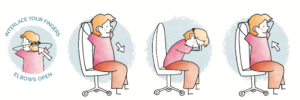 In my articles, I’am often talking about mobilising the body to enter more in contact and be more aware of your body. How to do this? For example with this easy exercise that combines breathing and movements.
In my articles, I’am often talking about mobilising the body to enter more in contact and be more aware of your body. How to do this? For example with this easy exercise that combines breathing and movements.
It can be practiced almost everywhere, sitting or standing, and, because it makes us move the torso – in coordination with breathing – it is very affective in helping us stopping automatic patterns (*).
Before starting the practice, you can quickly assess your state: how do you feel, how do you feel your body, how can you breathe.
Then make sure your back is straight, without forcing.
You interlace your fingers behind the back of your head with elbows open. As you exhale, slowly curve your back, closing your elbows around your head to create a stretch in your spine. As you inhale, slowly straighten up and open your elbows. Practice a series of 10 movements.
The movements and the breath are coordinated.
Pay attention that your shoulders are as much as possible relaxed, and not “attached” to your ears. Allow yourself to feel the stretches around the areas you are moving.
Also make sure that the elbows open wide when you straight up your back and close around the head when you curve it so to create a gentle stretch in the spine.
Last but not least: try to move slowly!
This is important for 3 reasons:
- It gives the chance to feel more the movements and their effects and so to be more present.
- It gives the chance to pay more attention to the different parts of the exercise and so to be more aware of your body.
- It allows the mind, that is “normally” very fast, to enter in a slower rhythm. This can even be perceived as uncomfortable, provoking the feeling that you are wasting your time or that you should just accelerate. This way of the mind to be hyper-active is an automatic pattern: the rhythm and the level of impulses received by the mind is very high but perceived as normal and desirable.
It is one of the reasons why is so difficult to detach the attention from technical devices.
So even if it is uncomfortable, try to keep a slow rhythm focusing on the different parts of the exercise and on your body.
At the end, take again a short moment to feel your state and to notice what has changed in your body.
As always, I will be happy to support you.
(*) Automatic pattern is a set of behaviours or attitudes that lock us in a certain perception of oneself, other and the world in general. These behaviours and attitudes concern the physical, emotional and mental levels.